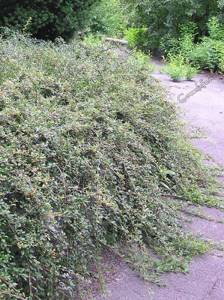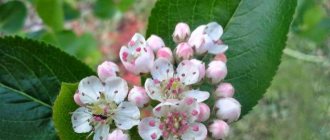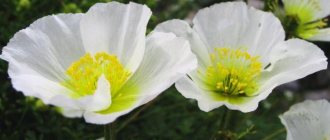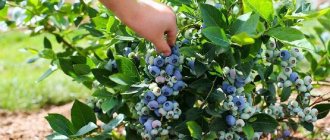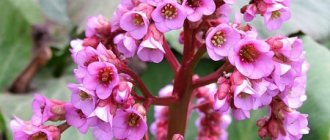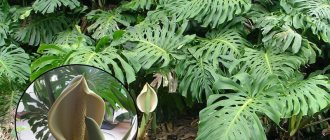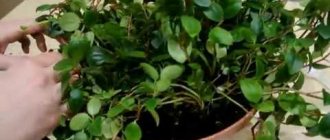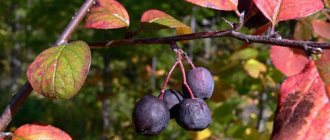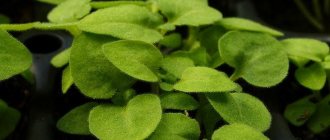Cotoneaster brilliant: rules for caring for a spectacular bush
The use of various shrubs in landscape design is a very common technique that allows you to decorate an area with beautiful green spaces, the care of which is not burdensome. Cotoneaster is one of the most popular shrubs, the decorative beauty of which will become a real decoration of the garden. We propose to consider the features of this plant, the rules and secrets of its cultivation.
Description of the cotoneaster shrub
The shrub belongs to the Rosaceae family. The plant is native to China and is also found in nature in Siberia. The natural habitat is considered to be rocky slopes and rocky river banks. Thanks to its unpretentiousness and visual beauty, it rightfully occupies one of the leading places among ornamental plants for the garden.
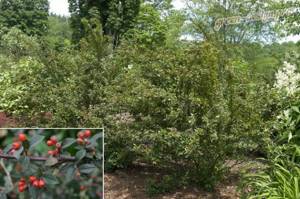
Cotoneaster lucidus is one of the most common cotoneaster species. An upright, deciduous plant whose height reaches three meters. The crown is spreading, can be one and a half times wider than its height. Upright shoots are densely pubescent with succulent foliage. Leaves up to five centimeters long have an ovoid, elliptical shape, pointed towards the edge. The top of the leaf blade is dark green and shiny. The lower part of the leaf has a yellowish tint and slight pubescence. In autumn, the foliage takes on a brownish-red hue.
Small flowers of the shrub are collected in corymbose inflorescences of 5-12 pieces each. Flowering is abundant. A large number of loose inflorescences during the flowering period practically cover the young foliage. The plant takes on the appearance of a soft pink cloud. Flowering period is May-June. The bush begins to bear fruit in the fourth year of life. The fruits are small, spherical. They have a black color. The berry contains three seeds. The fruit ripens in early autumn and remains on the stalks of the bush until frost.
Characteristics of the shrub Cotoneaster brilliant
Eastern Siberia is considered the birthplace of the bush. Today it is listed in the Red Book. Cotoneaster is a bush with upright growing branches. In a year it grows up to two meters. The foliage is very dense, has a rich green color; in autumn the leaves change color and turn purple. The shape of the foliage is pointed. The shrub blooms with small pink inflorescences, the flowers are corymbose, with 5-8 flowers on one stem.
Flowering begins at the end of May and continues until mid-June. After the flowering period, round fruits are formed, similar in appearance to berries. The fruits remain on the stems until late autumn. Cotoneaster begins to bear fruit after four years of life. The shrub is unpretentious and can grow in the shade in almost any soil. Resistant to frost, not afraid of drought or, conversely, high humidity. This plant is well suited for urban polluted air. Lives about 50 years. The roots of the bush are very strong, and it can be used to strengthen slopes. It has many varieties of its type.
Planting and caring for brilliant cotoneaster
It is preferable to place cotoneaster in a well-lit area of the garden; in the shade the plant blooms sparingly, the branches stretch unevenly towards sunlight. You should not plant it in areas where groundwater is close, lowlands and wetlands. An abundance of moisture leads to rotting of the rhizome.
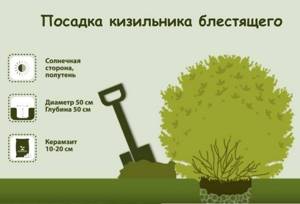
It is preferable to plant the bush in well-drained, permeable soil. Soil acidity should be at 6.5-7.5 pH. The composition of the soil is not important; fertile garden soil will do. If the soil is heavy enough, it is recommended to dilute it by adding sand, and pour a layer of expanded clay up to 20 cm into the bottom of the hole. for drainage.
The crop is planted in the ground in spring and late autumn. The shrub quickly adapts to natural conditions and grows well. To plant hedges, the distance between seedlings should be about 1.5 meters. Considering the lush crown of an adult plant, this distance is quite enough to create a dense green mass. When transplanting from a container, you need to carefully move the seedling, preserving the near-root soil.
After planting in the ground, the space around the seedling must be mulched. This helps keep the soil moist and weed-free.
Fertilize cotoneaster several times a season. In early spring, it is advisable to fertilize the soil with organic fertilizers. In summer - superphosphate. Mature crops do not need regular watering; the moisture in the soil is enough for them. Young seedlings need moderate watering.
How to propagate brilliant cotoneaster
The plant reproduces by seed and vegetative methods. Seed germination is quite low; about half of the seeds do not germinate. To improve germination, they are stored in the refrigerator for a long time. For example, seeds collected this season are placed in the refrigerator and sown only next fall. Before planting, they are soaked in warm water for a day. The floating planting material is rejected. The remaining seeds are buried 3-4 cm into the soil. Only a small part of the planted seeds germinates. You will also have to wait quite a long time for the first shoots. Some appear after a year.

The most effective method of propagation is cuttings. To do this, choose healthy, fifteen-centimeter shoots. Cotoneaster cuttings are carried out in July, after the end of the flowering period.
The cuttings are impregnated with a rhizome growth stimulator and buried in the soil at an angle of 45 degrees. The soil is watered abundantly. The planting is covered with a glass cover, periodically ventilating and moistening the soil. Over the course of several months, the root system develops and new shoots appear. In mid-autumn, the bush can be transplanted to the main place of growth.
Cotoneaster brilliant, planting and care
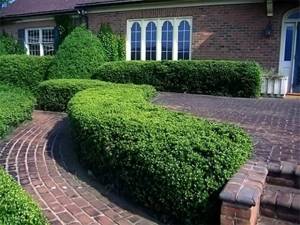
Landscaping a site is a complex and time-consuming process that requires a lot of effort and imagination. First of all, you need to select interesting and unusual plants with which you can create bright compositions, hedges and flower beds.
- Seed propagation
- Stage 1. Selection of planting material
- Watering
- Photo of cotoneaster brilliant in landscape design
As an option, you can use cotoneaster, or rather its most popular type - brilliant cotoneaster. This plant is particularly unpretentious and has a rather decorative appearance. The foliage of cotoneaster is especially striking, being bright green in summer and turning purple in autumn. By planting such a plant on your site, you can create unusual and unique compositions and garden hedges. And this, in turn, will become a decorative decoration for the garden plot.
In this article we will take a closer look at the features and description of the brilliant cotoneaster, and also learn about its popular forms. Let us note the main nuances of agricultural technology for growing this crop.
Features and description of cotoneaster
The brilliant cotoneaster is a deciduous shrub that has a fairly dense crown and is easy to trim. Cotoneaster belongs to the large Rosaceae family. Eastern Siberia is considered the birthplace of this ornamental shrub, but in nature this plant is already quite rare. In Siberia, brilliant cotoneaster can be found in thickets of bushes, as well as in undergrowth.
The name of this culture was given by the Swiss botanist Caspar Baugin. It consists of two parts, the first of which is “cotonea”, meaning “quince”, and the second “aster”, translated from Greek “having a similar appearance”. In simple words, cotoneaster is a plant very similar to quince. The similarity of these two crops is dictated by the common features of the leaves of some species and varieties.
Also, it is worth remembering that dogwood and cotoneaster are completely different plants. Edible berries can only be obtained by growing dogwood.
Description of cotoneaster brilliant:
- The brilliant cotoneaster is a deciduous shrub of medium height, although many species of the same family belong to evergreen crops and can delight with their beauty throughout the year.
- The shrub of the plant is formed by erect stems, which are very closely located to each other.
- Young shoots are covered with a small fluff, which disappears as the plant grows.
- The height of the brilliant cotoneaster can reach a maximum of 2 meters.
- The crown is very lush and dense, abundantly covered with small ovoid or oblong leaves.
- The leaves are small in size, on average they can reach from 2 cm to 6 cm. Their surface is smooth and shiny, hence the name of the species - brilliant cotoneaster.
- One of the main decorative features of the brilliant cotoneaster is its foliage, and more specifically the coloring of its leaves. They are dark green in summer and turn reddish or purple in fall.
- The shrub blooms in May with small white or pink flowers. which can be arranged singly or collected in racemose or corymbose inflorescences of 6-12 flowers.
- The flowering of brilliant cotoneaster lasts for a month.
- The fruits on this shrub appear 4 years after planting. They are also a decorative value of this crop. In autumn, the shrub with purple leaves and glossy black fruits looks very interesting.
- The fruits of cotoneaster are shiny, spherical, black in color, ripen in early September and remain on the branches until frost.
- This plant is characterized by fast growth and longevity. It is great for creating hedges that take any shape and tolerate pruning well. A shrub can grow in one place for more than 50 years.
- The homeland of the brilliant cotoneaster is the territory of Siberia, so it tolerates our frosts and cold weather well. It is for this reason that landscape designers and gardeners love him so much.
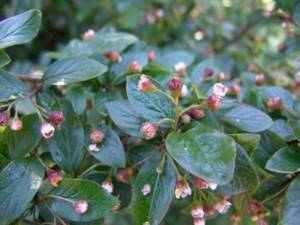
The brilliant cotoneaster is widespread in Russia, but it is very difficult to find it in nature; it is listed in the Red Book. Often, one of the forms of this species includes black cotoneaster and common cotoneaster, as well as horizontal cotoneaster. However, in most sources these crops are classified as independent species. Let's briefly look at the features of the most popular types of cotoneaster on a par with brilliant ones in Russia.
Cotoneaster aronia
- The natural habitat of this plant is considered to be the territory of the Caucasus, part of Siberia, like the brilliant cotoneaster. It is found in Central Asia and Northern China.
- Like brilliant cotoneaster, this shrub reaches a maximum height of 2 meters.
- The stems of the shrub are closely spaced to each other and have a slightly reddish tint.
- The leaves are also small, up to 6 cm in length, dark green in color.
- The flowers are pink, located on the bush in racemose inflorescences consisting of 5-12 small flowers.
- In terms of cultivation and growth conditions, this plant is very similar to brilliant cotoneaster, therefore it is excellent for our harsh climate.
- The only difference between the aronia cotoneaster is its edible fruits.
Common cotoneaster
- Quite widely distributed throughout our country; its natural habitat is the territory from the North Caucasus to the Baltic states.
- This shrub loves to grow on mountain slopes and sandstones.
- Like the shrubs described above, it can grow to a maximum height of 2 meters.
- Young shoots are covered with a small fluff, which adds resemblance to brilliant cotoneaster.
- The shrub is formed by rather densely spaced branches, which create a compact and rounded crown.
- The leaves are oblong and small in size. On average they can reach 5-6 cm in length.
- It blooms with small pale pink flowers.
- The difference from the brilliant cotoneaster is the color of the fruit - it is red.
These types of cotoneaster have very similar features to the brilliant cotoneaster. This also applies to the shape of the bush, the size of the foliage, the size and color of the flowers. Therefore, quite often all these shrubs are classified as one species.
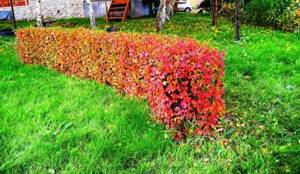
Reproduction of brilliant cotoneaster: the most common methods
If you wish, you can grow brilliant cotoneaster on your own without any problems. This culture is propagated in a large number of ways, so you can easily choose one that is convenient for everyone. The following methods are typical for this type of deciduous shrub: seed propagation, cuttings, dividing the bush and propagation by layering.
Seed propagation
- This method is used very rarely, since cotoneaster seeds have a very low germination rate. And the likelihood that you will receive high-quality seedlings for planting is very small. Seed propagation is used mainly in breeding.
- First of all, it is necessary to prepare planting material for this plant. To do this, after the fruits on the bush have fully ripened, they need to be collected. Try to collect as many fruits as the germination rate of the seeds of this crop is very low.
- Next, the fruits need to be dried a little, and then carefully separate the pulp from the seeds.
- After this, all seeds must be washed and left in water. Remove all floating seeds; they still will not yield a good harvest.
- Take the rest out of the water and place it on a dry surface to dry.
- Next, prepare a container, mix the seeds with peat and sand and moisten well. After which the container must be placed in the refrigerator at a temperature of 0 degrees for stratification. This process will last until spring.
- In the spring, after the snow has melted, stratified seeds can be sown directly in open ground, having previously prepared the place for planting. Seeds are sown in beds, which must be done at a distance of 15 cm from each other.
- You can also plant cotoneaster seeds in prepared containers. They must first be filled with a soil mixture consisting of peat and sand. It will be possible to plant seedlings in open ground only after a year in the spring.
- However, you should not expect uniform and good germination of seedlings; at best, you will get 60% of the total number of seeds. In addition, fruiting can begin only 4-5 years after planting.
Reproduction by cuttings
- This method is easier and more common and allows you to get better results.
- Cotoneaster brilliant can be propagated by green cuttings and woody cuttings, which are harvested at different times.
- Green cuttings for propagation must be harvested in the second half of June. On the bush, select the strongest and most flexible shoots, which need to be cut 10-15 cm long. The main thing is that the planting material has at least 2 internodes.
- Woody cuttings should be harvested at the end of autumn. For this purpose, strong and healthy shoots are also selected. Until spring they are tied and stored in the basement. In spring, cuttings need to be cut 10-15 cm long. Make sure that each cutting has 2-3 buds.
- Before planting, the planting material must be treated with a special solution of a root stimulant, for example, Kornevin. You need to keep the planting material in a container with the solution for 24 hours.
- It is necessary to root cuttings in a greenhouse or greenhouse. You can also cover the planted seedlings with regular film.
- Before planting, prepare a soil mixture, which should consist of fertile soil, peat and sand.
- The cuttings are rooted at an angle of 45 degrees; they need to be buried approximately 5-6 cm.
- Further care for the cuttings consists of regular watering with warm water, loosening the soil around the planting material and ventilating the greenhouse. After rooting, the seedlings must be transplanted into open ground to the chosen location. It should be remembered that even with cuttings, the percentage of obtaining strong and healthy planting material is 30-95%. Therefore, caring for cuttings must be very careful and attentive.
Reproduction by dividing the bush
- This is another way to propagate brilliant cotoneaster, which is easy to apply yourself on your own site. It requires at least one plant bush.
- It is best to divide the cotoneaster bush in the spring, until the buds appear.
- Take a sharp shovel and carefully remove the shrub from the soil, trying not to damage the root system of the brilliant cotoneaster.
- Using a sharp knife, divide the cotoneaster root system into the required number of parts, the main thing is that each section has young roots and buds.
- Prepare planting holes for young plants, add a layer of drainage and fertile soil.
- This method is most often used when replanting an adult plant or renewing it.
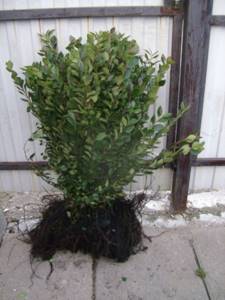
Reproduction by layering
- It is quite difficult to propagate brilliant cotoneaster using this method; most often it is used to propagate creeping forms of cotoneaster. But you can still try.
- In spring, select the strongest and most flexible shoots on the shrub; it is better to give preference to the lower shoots themselves.
- Dig small grooves around the bush and carefully bend the selected shoots into them.
- Cover them with soil, leaving only the tops of the branches.
- Caring for layering consists of watering and weeding.
- At the end of summer and beginning of autumn, if the cuttings are sufficiently rooted, young shoots can be disconnected and planted in the selected area.
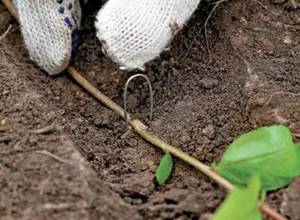
To obtain a beautiful and ornamental shrub, you need to make a little effort and carefully prepare. It is important to prepare high-quality and healthy cotoneaster seedlings, as well as come up with a planting plan and find the most optimal place on the site to plant the plant. If you follow all the rules properly, you will get a beautiful plant that will certainly decorate your site.
Stage 1. Selection of planting material
- Choosing brilliant cotoneaster seedlings will be the key to obtaining a beautiful shrub.
- Seedlings can be obtained using green and woody cuttings rooted in a greenhouse.
- An easier way is to buy brilliant cotoneaster in a specialized store or agricultural company that professionally breeds various plants.
- When purchasing, be sure to carefully inspect the seedlings. Young plants should be free of visible damage and signs of pests and diseases.
- If you buy seedlings in containers, pay attention to the soil in them. It should be clean and damp.
- Before purchasing, think about the composition that you ultimately want to get on your site.
- Cotoneaster is best planted in open ground after the leaves fall in the fall, so it is best to buy seedlings with a closed root system so that the roots do not dry out. Seedlings in containers can stand until the planting time you need. Bare-root plants are best purchased just before planting.

Stage 2. Selecting a landing site
- The brilliant cotoneaster prefers to grow in sunny areas, but will also feel great in the shade.
- Choose a place on the site that is protected from strong winds and drafts.
- It is important that the groundwater is deep enough, since the root system of this crop cannot tolerate excess moisture.
- The choice of place for planting cotoneaster will directly depend on the landscape design you need. This plant can be planted along garden paths as a border; cotoneaster is also ideal for creating hedges.
- You can choose a place against the background of the lawn for a single planting of brilliant cotoneaster.
- Alternatively, give this shrub a place among other plants, both ornamental and flowering.
Stage 3. Selection and preparation of soil for planting
- Cotoneaster is not very demanding on the composition and fertility of the soil.
- Before planting, it is important to carefully dig up the area chosen for planting cotoneaster seedlings. You need to till the soil with about two shovels' worth.
- While digging, you can add a little peat and sand, as well as rotted manure.
- Digging up the soil is possible some time before planting. If you plant seedlings in the spring, then prepare the soil in the fall. If planting is in autumn, then the area is processed in the spring. Just before the process of planting cotoneaster, the soil is once again loosened and leveled.
Technology of planting cotoneaster brilliant
- It is best to plant brilliant cotoneaster in open ground in the fall after leaf fall, although spring planting is also allowed.
- Before planting, thoroughly loosen the soil again if you have previously cultivated the selected area in the spring. If such a process has not been carried out, then the place must be dug up and leveled.
- Purchased cotoneaster seedlings must be filled with water in containers so that they can be carefully removed.
- In the selected area, prepare planting holes for planting and soil mixture. Planting holes should be 50 cm deep and 50 cm wide. It is also important to maintain a certain distance between cotoneaster bushes. It should be approximately 50-200 cm depending on the planting plan. The soil mixture for planting should consist of peat, turf soil and sand; you can also add rotted manure and lime.
- Be sure to add a 20 cm layer of drainage to the bottom of each hole to prevent stagnation of water at the root system of the plant. Broken brick, gravel or expanded clay can be used as drainage.
- Place a small mound of prepared soil mixture onto the drainage layer.
- Carefully remove the cotoneaster seedlings from the containers and place them in the planting holes.
- Carefully fill the seedlings with soil, making sure that the root collar is strictly level with the soil surface.
- Lightly press the soil with your hands and water thoroughly.
- After watering, the trunk circle of each plant can be mulched with dry peat or tree bark.
- When planting a hedge of brilliant cotoneaster, you need to dig not holes, but one trench.
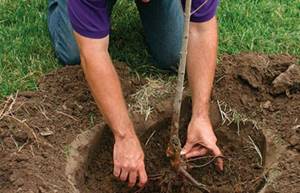
The full growth and development of the plant depends on your attention to it. Caring for brilliant cotoneaster consists of timely and regular watering, loosening and mulching the soil, as well as proper pruning and protection from pests and diseases. Let's look at everything in more detail.
Watering
Cotoneaster is not demanding of moisture; most often a young plant needs to be watered. This will contribute to better rooting of the shrub. Subsequently, watering is reduced and moistened the soil around the plants as needed. Cotoneaster bushes require more water during periods of severe drought and heat.
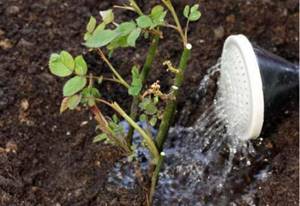
Loosening and mulching
Periodically, after watering, the soil in the tree trunk circle must be loosened to saturate it with oxygen. During this process, all weeds that interfere with the growth of the plant are removed. To reduce the amount of loosening and watering, you can periodically add mulch to the tree trunk circle. Use dry and clean peat or tree bark as mulch.
Top dressing
- When planting cotoneaster, lime and rotted manure are added to the planting holes.
- Before active growing season, each plant must be fertilized with nitrogen fertilizers, for example, urea.
- Later, in mid-summer, cotoneaster bushes can be fed with potassium and superphosphate fertilizers.
Pruning cotoneaster
- The brilliant cotoneaster grows very quickly, so pruning is an integral part of caring for this plant.
- At any time of the year, sanitary pruning can be carried out, during which all damaged and dry shoots are removed.
- An adult plant sometimes requires rejuvenating pruning, which is carried out in the spring before buds appear.
- The main pruning is formative, which is also carried out in the spring before the active growing season begins. During this pruning, the bush can be given absolutely any shape: a ball, a square and any intricate geometric shapes. When pruning, you need to take sharp scissors and remove a third of the growth on the annual shoots.
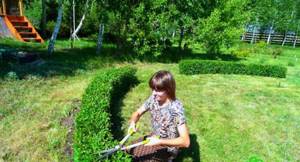
Cotoneaster is resistant to various diseases and pests. However, occasionally this plant also needs your protection.
Pests:
- Spider mite. This pest appears as a thin web on the leaves and stems of the plant. To combat it, you can use special drugs, for example, Actellik.
- Aphid. Signs of this pest are wrinkled and wilted leaves. Insecticides can be used for control.
- Mol. It can also sometimes attack cotoneaster. To combat, you can use special drugs: “Rogor”, “Korbofos”.
Diseases:
- Fusarium. This disease is most common in this plant. Parts of the plant begin to rot, which can lead to the complete death of the bush. It is imperative to remove all affected parts and treat the entire plant with fungicides.
Shelter for the winter
The brilliant cotoneaster is a plant resistant to our severe frosts and winters, so no special shelter is required.
Use of cotoneaster brilliant in landscape design
- Cotoneaster is a favorite plant among landscape designers, because it can be used to create the most incredible and beautiful garden compositions.
- This shrub is great for creating a hedge.
- It can be used to frame borders and garden paths.
- This plant also looks great in single plantings against a green lawn.
- You can easily combine brilliant cotoneaster with other plants.
Photo of the brilliant cotoneaster in landscape design.
You can more clearly see all the features and options for using the brilliant cotoneaster in landscape design in the photos below.
Cotoneaster is a wonderful ornamental plant that, with proper care, will become an indispensable decoration for your garden.
Cotoneaster brilliant in landscape design
The uniqueness of the plant lies in the fact that with the help of a shaping haircut you can make any shape from it. In garden design, the bush looks great when planted alone, trimmed in a style that supports the overall style of the space. It is also used to create beautiful hedges and borders that complement the beauty of the garden.

Properly planted glossy cotoneaster bushes will create an excellent fence in your garden.
A hedge of brilliant cotoneaster is especially charming during flowering. Its soft pink flowers add special beauty to the space.
Advantages and disadvantages of a hedge of brilliant cotoneaster
Cotoneaster brilliant is a shrub found naturally in China, Eastern Siberia, Central Asia, and Altai. It is obvious that the plant surviving in such harsh conditions is unpretentious, cold-resistant and shade-tolerant. And the dense crown makes it decorative.

Due to its unpretentiousness and ability to adapt to adverse environmental factors, brilliant cotoneaster is used for landscaping city parks and squares
What does the plant look like:
- bush height - 1.7–2 m, shoots 4–5 mm thick, erect, densely leafy;
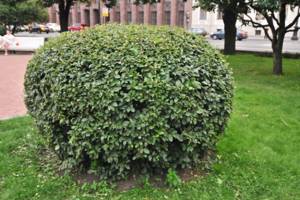
The cotoneaster bush is relatively low, the shoots are thin, but not drooping

The leaves of the brilliant cotoneaster are small, glossy; in autumn the bush turns into a real riot of colors

The flowering of cotoneaster brilliant cannot be called very catchy, but the small flowers look elegant
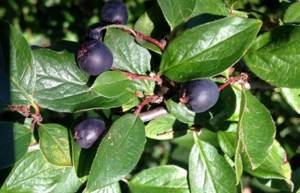
The fruits of the brilliant cotoneaster are most often eaten for medicinal purposes.
Advantages of a hedge made of brilliant cotoneaster:
- decorative (a flowering plant, green leaves, and a riot of colors in autumn look beautiful);
- durability (lifespan - about 50 years);
- frost resistance up to -40°C;
- the ability to survive even in harsh conditions (undemanding to soil quality, does not suffer from drought, waterlogging, gusts of wind, temperature changes, lack of light, bright sun, polluted city air, dust);
- wide possibilities of use in landscape design (“killing” a cotoneaster even with a very inept pruning is extremely difficult; the hedge can be given the most unusual shape);
- attracting pollinating insects to the site (cotoneaster is a good honey plant) and the possibility of using the fruits in folk medicine (as an antiseptic, for the treatment of inflammation, diseases of the gastrointestinal tract).
Cotoneaster brilliant description photo
This plant first appeared in Eastern Siberia. Today, this shrub is almost never found in the wild, which is why it was listed in the Red Book. It is very popular among professional gardeners. Fruits appear on the bush at the age of 4 years.
Cotoneaster has both positive and negative sides.
Positive:
– Perfectly combined with any composition of plants.
- Unpretentious. The gardener does not have to care for this shrub every day.
– Insensitive to various temperature changes. It tolerates both frost and drought remarkably well.
– Gets along well in any soil.
– Well tolerates various air pollutants.
Negative:
Among the negative aspects, only one can be highlighted - the plant requires that its branches be cut off quite often, otherwise it may lose its attractive appearance.
Today this plant can be found in a large number of different parks and gardens, in the form of a shiny hedge. No visitor can ignore a plant with such bright leaves and flowers, and visitors are also attracted by birds that always sit on cotoneaster berries. This gives the garden or park a certain zest inherent only in true nature.
When cotoneaster is presented as a hedge, it becomes a real decoration for the site, but separately growing shrubs also look very nice.
Planting and necessary preparation
Cotoneaster brilliant adapts to almost any conditions. But the best option for it is a well-lit place with groundwater lying 1.5–2 m below the soil surface. Please note that due to constant strong wind blowing in one direction, the fence may gradually “lean”.
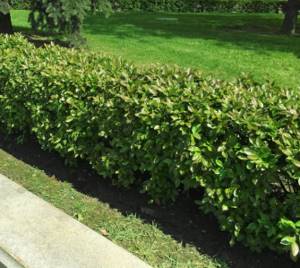
Cotoneaster is shade-tolerant, but if possible, form a hedge from it in well-lit areas
Cotoneaster especially likes alkaline soil (pH 6.6 and above) - in acidic soil the growth rate is reduced. Practice also shows that the brightest leaves in autumn are obtained from bushes growing in a sandy substrate.
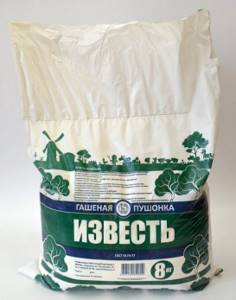
Slaked lime, as well as dolomite flour, crushed chalk, and powdered eggshells help neutralize excess soil acidity, providing the desired acid-base balance for cotoneaster.
You can plant cotoneaster in spring (April-May) and autumn (October). In the first case, the growth buds should not yet “wake up”; in the second, wait until the leaves fall. The selected area is marked with rope and pegs to ensure the fence is level. Then they dig a trench with a depth and width of 60–70 cm. Any drainage is poured onto the bottom (layer up to 10–12 cm).

Marking is necessary in any case, it is especially important if a complex hedge configuration is planned
The trench is filled one third with a mixture of turf soil, coarse sand and compost (2:1:1) with the addition of complex fertilizer containing nitrogen, potassium and phosphorus (80–100 g per linear meter) and slaked lime (300 g per linear meter).
Green fence planting scheme
To form a hedge, 30–35 cm is left between cotoneaster seedlings. To make it denser and denser, it is recommended to plant the bushes in two rows in a checkerboard pattern with an interval of 40–45 cm. The maximum distance at which planting still resembles a hedge and not separately standing bushes - 1.2–1.5 m.

Planting in three rows is not recommended. The middle one will be almost impossible to reach for pruning. A lack of sun will cause uneven growth; lack of aeration means a greater risk of disease development.
The actual planting of bushes follows a standard algorithm. The roots of seedlings placed in a trench are sprinkled with small portions of soil, periodically compacting it in the process. The root collar is left 2–3 cm above the ground. The planted cotoneaster is watered (5–7 liters per bush), it is advisable to mulch the soil.
Video: planting a hedge of brilliant cotoneaster
Cotoneaster propagation
This culture is propagated:
- seeds (for industrial propagation),
- layering,
- green cuttings,
- dividing the bush.
Propagation by seeds
All cotoneasters reproduce quite well by seeds. Many species self-sow abundantly. These are shiny, multi-flowered, vesicular cotoneasters.
- In October-November, the berries are picked, crushed and kneaded, laid out on a garden bed and sprinkled with soil (lightly, in a small layer).
- In spring (and sometimes in June) seedlings appear, which are thinned out if necessary.
- After 2-3 years, the grown seedlings are transferred to a permanent place.
- When transplanting, pinch off the tops.
- Before planting, young plants need to be covered for the winter.
Reproduction of cotoneaster by layering
For amateur gardeners, it is easier to propagate cotoneasters using layering. More This method is suitable for propagating creeping species.
- To do this, the lower well-developed shoot is bent to the ground, sprinkled with moistened soil and spilled with root solution. In this case, the end of the shoot, about 20-30 cm long, always remains free.
- Throughout the warm season, the cuttings, covered with soil, should be periodically moistened.
- The rooted shoot is separated from the mother plant 3-4 weeks before transplanting into its place.
Propagation by cuttings
Not all types of cotoneaster can be successfully propagated by cuttings. This type of propagation is well suited for ground cover species (horizontal cotoneaster, Dummera). Cuttings of cotoneasters brilliant, black-fruited, vesicular, multi-flowered, take root reluctantly, this method is practically not applicable for them. Cotoneaster can be propagated by green cuttings.
- To propagate creeping species, cuttings can be taken from May to mid-July.
- For cotoneaster - in the first half of June. The length of the cutting is 10 cm, 2 leaves are left on it.
- It is advisable to treat sections of cuttings with a root formation stimulator (powder or dip in solution for a day).
- Light soil is used for rooting. For example, a mixture of peat and sand.
- In order for the cuttings to take root better, it is better to organize a rooting bed in a greenhouse
- Cotoneaster cuttings can be rooted under a plastic bottle with the bottom cut off and the neck open.
- The soil in the garden bed is kept moderately moist.
- The first roots appear on the cuttings no earlier than a month later.
- When new leaves begin to appear on the cuttings, rooting has been successful. You can gradually accustom the seedlings to fresh air by temporarily removing the bottles. After 1-2 weeks they can be removed completely.
- For the winter, seedlings must be covered with a layer of foliage, peat or humus.
- Next spring, young plants are planted in a permanent place.
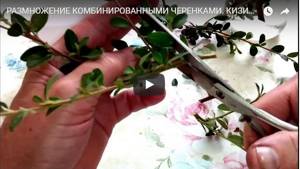
Reproduction of cotoneaster by dividing the bush
This is the easiest way of reproduction, moreover, with an almost guaranteed result.
The mother plant is dug up and divided into several parts with a sharp shovel.
Each individual bush is planted in its allocated place, as described in the “Planting Technology” section.

Features of hedge care, how to cut it
Cotoneaster requires minimal care during the season:
- Watering. If it rains at least once a week, the plant will make do with natural precipitation. In extreme heat and drought, the bushes are watered once every 3–5 days (12–15 liters per plant). After watering, loosening is desirable. It is useful to spray them with a watering can or hose with a sprayer once every 2-3 weeks, washing away dust and dirt.

It is recommended to water the brilliant cotoneaster from time to time, washing away dust and other contaminants.
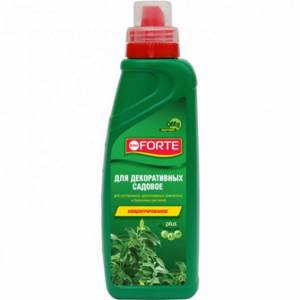
In principle, the brilliant cotoneaster can do without fertilizers at all, but it is still better to spend a little time and feed the bushes
Video: tips for caring for brilliant cotoneaster
Cotoneaster is prone to fungal diseases, especially if rainy, cool weather contributes to this. For prevention, bushes and the soil under them in early spring and late autumn are sprayed with a solution of any fungicide (copper sulfate, Bordeaux mixture, Skor, Oksikhom, Strobi). Having discovered characteristic symptoms, they use them. Typical plant diseases:
- fusarium (the roots rot, the rot gradually spreads to the above-ground part, appearing in the form of “wet” dark spots);
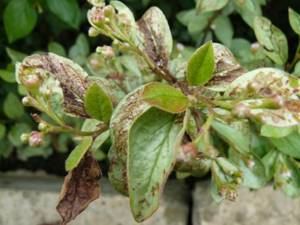
Fusarium wilt develops very quickly; on the above-ground part of the plant it appears only when the roots have already been irreversibly damaged

Powdery mildew seems like a harmless coating that can be easily wiped off, but in fact it is a serious disease.
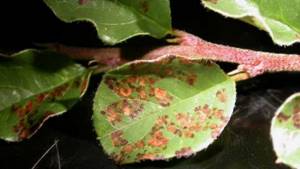
Rust-affected tissues gradually die, leaves fall off
The most dangerous pests are aphids and scale insects. They feed on plant sap. To repel insects, any plants with a characteristic pungent aroma can be planted next to the fence.
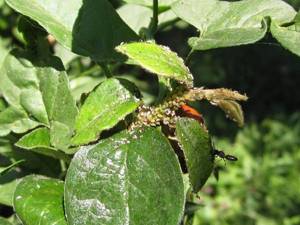
Aphids are an almost omnivorous garden pest; they attack plants in entire colonies, preferring to settle on the tops of shoots, young leaves, and buds.
If prevention does not help, the aphids are destroyed using any general insecticides (Tanrek, Mospilan, Iskra-Bio). Fufanon and Aktara are effective against scale insects.
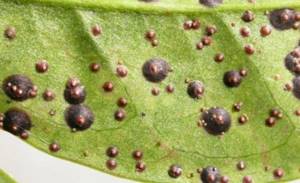
Folk remedies against scale insects are ineffective - the pest is reliably protected by a “wax” shell
Pruning is carried out starting from the 3rd–4th year after planting (the bushes should grow to 50–60 cm) 2–4 times per season according to the following principles:
- Every year at the beginning of spring sanitary pruning is required; in the fall the bushes are not touched;
- cotoneaster is pruned mainly from the top, activating the process of growth of side shoots;
- branches are shortened by a maximum of a third so that the height of the bush increases by 5–8 cm annually;
- To form a simple fence configuration (rectangle, trapezoid, triangle), stretched ropes are used; for more complex contours, templates made of wooden slats and bars are used.
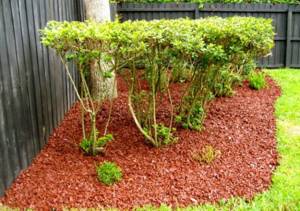
The brilliant cotoneaster is trimmed mainly from above, stimulating the branching of side shoots
For forming a hedge, brilliant cotoneaster is one of the best options. The plant adapts to almost any conditions, easily tolerates pruning, and the gardener spends a minimum of time and effort caring for it. The only objective drawback is that the “fence” is susceptible to fungal diseases, but regular prevention will prevent infection.
Cotoneaster brilliant in your garden. Planting, care, reproduction
A fast-growing shrub from the Rosaceae family, decorative from early spring to late autumn - brilliant cotoneaster. Planting and caring for the plant is not difficult; the plant is unpretentious. Cotoneaster is frost-resistant and easily tolerates drought. It is not harmed by strong gas pollution and dust of a big city. At the same time, cotoneaster is attractive in summer with its shiny leaves, in spring it is strewn with small pink flowers, in autumn with shiny black berries and foliage shining in shades of purple, red, and brownish colors. For this and for its rapid growth, it is popular among gardeners. Without the formation of a crown, the cotoneaster bush reaches a height of 3 m with a crown diameter of 2-3 m. Cotoneaster is a good honey plant that attracts beneficial insects to the garden.
Planting cotoneaster brilliant in the garden
Place for cotoneaster
Cotoneaster grows well both in bright sun and in the shade. In the wild, it lives on mountain slopes, so when planting in the garden, groundwater should not be close. The best time for planting is in the spring before the buds open or in the fall, at the beginning of leaf fall.
Soils
The shrub is undemanding to soils; its main desire is neutral or slightly alkaline, acidic areas need to be limed. The best mechanical composition of the soil for it is medium loam, but other soils are also suitable; you should not plant cotoneaster only in sand.
Planting cotoneaster seedlings
Holes for planting are dug 50x50x50 cm in size and deeper if drainage is required, which is laid directly at the bottom of the planting hole with a layer of 20 cm. These are broken bricks and gravel. Then pour a heap of prepared substrate of the following composition: 1 part each of peat, humus and garden soil from a dug hole and 2 parts of turf soil. A seedling is placed on top, the roots are straightened and covered with a nutrient mixture, making sure that no voids are formed. The soil is compacted and watered. The root collar should be at ground level. Then the tree trunk circle is mulched with humus or peat in a layer of 6-8 cm. If the cotoneaster is planted as a hedge, not individual holes are dug for planting, but a trench.
Planting cotoneasters
All cotoneasters can easily be planted. Shrubs with an open root system are planted in a permanent place in the spring - during the period after the soil thaws and before the buds begin to open, or in the fall - from the massive fall of leaves to the first frost. For them, spring planting is most optimal, and for cotoneaster and chokeberry, autumn planting is also suitable.
|
In preparation for planting a cotoneaster hedge, pull the rope tightly along the line of the future row of green fencing. Only if this condition is met does the landing turn out beautiful and even. For a hedge, dig a trench 50-70 cm deep and up to 50 cm wide, for medium and small species - 35x35 cm. After planting, the soil around each plant must be compacted tightly so that voids do not form in the root zone, leading to drying out and death of the bush.
It is difficult to imagine today a high retaining wall built on a slope without the presence of horizontal cotoneaster. However, in our conditions, it is advisable to limit its use to plantings of 1-5 plants that are not difficult to cover. The characteristic habit and the way the shoots of Dummer's cotoneaster grow make this shrub indispensable for alpine hills and terraces. Ground cover cotoneasters are good in rock gardens, as they are able to entwine flat stones with branches and perfectly cover the soil around tree trunks and decorate the edges of mixborders, provided there is good lighting.
Features of caring for brilliant cotoneaster
Caring for young bushes
When caring for young plants, remove weeds in a timely manner, loosen and mulch the soil in the tree trunk circles. During the dry period, fragile bushes will require infrequent watering. Feed with complete mineral fertilizer, diluting it in water according to the instructions, 2 - 3 times during the summer. Fertilizing is combined with watering.
Caring for mature plants
Adult cotoneaster bushes are fed with complete mineral fertilizer in the spring. An adult cotoneaster does not need watering; the soul is much more important for its health. From time to time you need to wash off the dust accumulated on the leaves, especially if the bushes grow like a hedge. The brilliant cotoneaster tolerates pruning well; its bushes can be given any desired shape.
Cotoneaster hedges are made from a meter to one and a half meters high. But you can also cut it as a low border with a height of 50-60 cm. In this case, the plants will need regular feeding. In addition, in a harsh snowless winter in the North-West, a short-cropped bush without shelter can freeze. One caveat of growing cotoneaster as a hedge is that it needs regular trimming, otherwise the rapidly growing shoots will create a sloppy appearance.
Cotoneaster care
Caring for various types and varieties of cotoneaster is not difficult and takes a lot of time. It consists of:
- watering,
- fertilizing and
- trimmings.
Top dressing
During the season, usually only two feedings are carried out.
For the first time, cotoneasters are fed with the onset of spring warmth. Complex fertilizers (nitroammophoska, urea) are best suited for this feeding.
The second time fertilizing is done before flowering begins. To do this, choose fertilizers that contain phosphorus and potassium (superphosphate, potassium magnesium, potassium sulfate). Before fertilizing, be sure to water the plants well, and then scatter fertilizers near the bushes.
Watering
Newly planted plants must be watered throughout the warm season as needed. After each watering, the soil around the bush is loosened and all weeds are removed.
Adult, well-established cotoneasters need regular watering only in hot and dry times.
Trimming
- Cotoneaster perfectly withstands pruning and trimming; it can be used to form dense and dense hedges, as well as shapes with a wide variety of shapes, from simple to fancy.
- Using pruning, you can also correct the shape of creeping cotoneasters: direct the shoots in the desired direction, limit the growth of branches and thin out the volume of the bush.
- When planting, for better branching of the bushes, you need to pinch the shoots and remove the apical buds.
- Formative pruning begins from the third year of the plant’s life. Every year in April, shoots are shortened by at least one third. In young bushes, the upper buds are pinched in mid-summer.
- Mature dense bushes are trimmed twice a season: in April and mid-summer.
- Like all ornamental shrubs, cotoneasters undergo sanitary pruning , during which broken, dried out and deformed branches are cut out.
- In early spring, before the buds begin to open, shrubs, if necessary, undergo anti-aging pruning , when old branches are removed, which stimulates the subsequent active growth of young ones.
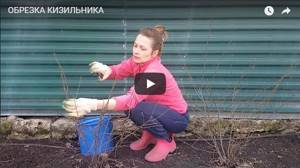
Cotoneaster in winter
Different types of cotoneaster have different winter hardiness .
Species: shiny, splayed, entire-edged, black-fruited, multi-flowered - very frost-resistant species.
Bladderwort cotoneaster usually overwinters well, but young plants can sometimes freeze.
The horizontal and small-leaved ground cover species are not very winter-hardy; in winters with little snow, the current year's growth may freeze and the plant loses its decorative appearance, although the shoots are quickly restored in the spring.
Dummer's cotoneaster is even less winter-hardy; annual shoots often freeze slightly, and in frosty winters the plant receives significant damage and can freeze completely.
It is advisable to cover these species for the winter. For shelter, use spruce branches or cover the top with fallen leaves, large sawdust or peat with a layer of 3-6 cm.

Reproduction of cotoneaster brilliant
- Seeds. For sowing, full-bodied seeds are selected from ripe cotoneaster berries. The pulp is washed in water and those seeds that float to the surface are thrown away; they are obviously not germinating. Cotoneaster seeds are sown in the soil in the fall. The germination percentage is low, 40-60%. That is why the plant in its homeland is listed in the Red Book of Endangered Species, but in its “domesticated” form it lives and thrives. Seeds are sown to a depth of 0.5 - 0.7 cm, sprinkled with substrate. Add another 1 cm of sand on top. Some of the seedlings will appear in the spring, the other part will sprout another year. During the summer, the babies are watered, fed, weeded, and the soil is loosened. If the seedlings are sparse, leave them to grow in the garden for 2 years, then transplant them into the garden.
- By cuttings. For green cuttings, choose strong but flexible young shoots. This is done in the 2nd half of July. Cut cuttings 10-15 cm long so that each has 2 internodes. Treat with a root formation stimulator (Kornevin powder or Heteroauxin in a concentration of 1 tablet per liter of water). The cuttings are planted under a film cover in a prepared nutrient substrate. It is prepared in the same way as for planting ready-made seedlings, only the soil from the pit is replaced with sand and another 3-4 cm layer of clean sand is poured on top. The cuttings are planted at an angle of 45 degrees to a depth of 5 cm. When the cuttings take root, the cover is gradually removed. By autumn, the plants are planted in open ground, providing them with cover with spruce branches or fallen leaves during the first winter. Shoots for woody cuttings are harvested in late autumn and stored in basements, buried in sand. In the spring, cuttings with 3-5 buds are cut and rooted in the same way as green ones.
Brilliant cotoneaster: propagation by cuttings
In order not to purchase a lot of shiny cotoneaster seedlings on the market for a hedge, it is recommended to buy 1-2 bushes and plant them on the site. In the second year they will need to be trimmed to give shape and decorativeness. In the process of these activities, twigs will remain that can be forced to take root.
- The cuttings are placed in a liquid with a growth stimulant diluted with water for a day.
- They are then moved into well-fertilized soil at a 45-degree angle. The soil should be loose and light. It is usually made up of two components: peat and sand.
- After “planting”, water it with warm water and cover it with a five-liter plastic bottle with the bottom cut off and the lid facing up. It is removed on hot days. Regular watering of the cuttings is carried out through it.
The best time to collect and root cuttings of brilliant cotoneaster is June. By this month, the branches gain strength and become capable of reproduction. By this time, many roots have formed in the lower part of the cuttings. Next spring, the cuttings can be transplanted to a permanent location. They will take root well and become a wonderful decoration in the garden.
Cotoneaster brilliant in landscape design
This is the best plant for growing low hedges. With its help, you can divide the area into zones. Several types of cotoneaster planted side by side go well together.
Compositions of flowers decorated with a low closed border of cotoneaster look elegant.
Bushes, trimmed in the shape of hemispheres, balls or flat pillows, are combined into compositions and distributed over the lawn or garden, placed in mixborders. This is reminiscent of Japanese style elements and gives the garden a sense of integrity, order and harmony.
Cotoneaster brilliant planting care and propagation photo video
Today it is very fashionable to organize gardens so that in the end they turn out to be environmentally friendly and do not require a lot of care. This fact is explained by the fact that people try to turn such gardens into a natural and pleasant place of relaxation. At the same time, the design should be as close to nature as possible. Therefore, a living collection of plants is an integral part of modern landscape design. Now the place of bright summer flowers is taken by deciduous and coniferous shrubs. Among them, brilliant cotoneaster is especially popular in landscape design.
Cotoneaster brilliant in design
In this article you can get acquainted in detail with the diversity of this plant. Recommendations for growing bushes on your site will also be provided. You will learn how reproduction occurs, as well as what care it needs. You can also find in this article a description of the most popular types of this shrub in design.
What is Brilliant? Its varieties and types
Shrubs of the genus Cotoneaster belong to the Rosaceae family. There are about 100 species of representatives of this genus.
- Such shrubs are evergreen, their leaves are medium-sized with solid edges of a simple shape, which become reddish in autumn.
- It blooms with pink or white small flowers that can be collected in clusters or grow individually.
- This plant also has fruits - berries that are shaped like apples and are red or black in color.
Lucidus
Brilliant has another name - lucidus. It usually grows in the harsh conditions of the Transbaikal region. Lucidus is protected by the Red Book.
It is a shrub whose height reaches two meters.
- The leaves of this plant fall off.
- Lucidus has a thick, elongated crown, densely covered with leaves.
- It blooms throughout May, its flowers are small in size and pink in color. An inflorescence can contain from 5 to 12 flowers (as in the photo)
- The berries of the bush are similar to black rowan, but they cannot be eaten. They ripen in the fall and do not fall off for a long time; they can last until spring.
Chokeberry
There is also a variety of this shrub called chokeberry cotoneaster. It looks a little like glitter.
- The difference is the matte large leaves.
- The height of such a dogwood bush can reach almost three meters.
- This plant is not afraid of winter frosts.
A chokeberry hedge is an ideal option for its use in garden design.
Dammera
- The height of an evergreen creeping shrub can reach up to 10 cm.
- The leaves of this shrub are oval-shaped and more leathery.
- This species is popular in European gardens because, as it grows, it creates a luxurious lawn (pictured).
- It tolerates wintering well under snow.
- The fruits of this shrub are bright red berries.
Lawn from Dummer
Spread
This is a shrub that grows up to a meter in height and has a dense crown.
- This species is considered rare.
- The leaves are round in shape, their size is up to 2 cm.
- Easy to cut. Looks ideal in compositions with coniferous plants.
- Also fits perfectly into the design of rocky gardens.
- It is also used to create borders.
- May freeze when it thaws.
